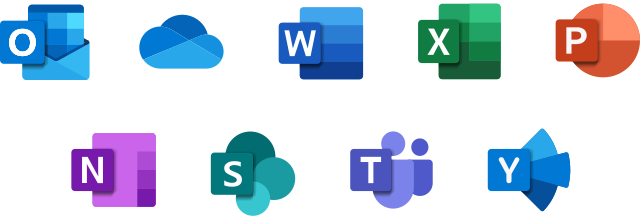Office 365 Explained
What is Office 365?
Microsoft offers a range of productivity tools and programs for personal and commercial use through its subscription-based Office 365 service. It has cloud-based access to well-known programs, including Word, Excel, PowerPoint, Outlook, and OneDrive. With its use, users can create, edit, collaborate on, and share documents, spreadsheets, presentations, and emails from any device with an internet connection. Additionally, it offers features like cloud storage, email hosting, video conferencing, and collaborative workspace solutions, making it a comprehensive productivity suite for individuals, families, and businesses.
Key features of Office 365 Business Standard include:
Assess and use the latest versions of Office applications on up to five devices per user.
1 TB of OneDrive for Business storage per user
Ability to host online meetings and video conferences with Microsoft Teams
Collaborate on documents in real-time with co-authoring and commenting features.
Create and share professional-looking presentations with PowerPoint Designer
Use AI-powered tools like Editor and Ideas to improve writing and presentation skills.
Availability in mobile apps for iOS, Android, and Windows devices
Get automatic updates and upgrades to the latest versions of Office applications.

Office 365 Business Standard in AUD costs $17.20 per user per month or $206.40 per user per year if paid annually. This subscription includes all the above features, access to Microsoft support, and a guaranteed uptime of 99.9%.
Microsoft offers other plans with various features and pricing options to meet the businesses’ diverse needs. You should evaluate and select the plan that best aligns with your enterprise’s requirements and budget. Additionally, a Business IT Support team can assist you in evaluating these plans, providing insights and recommendations based on your business needs.
Office 365 Implementation
When switching to Office 365 from another provider, there are a few key steps that need to be taken to ensure a smooth transition:
- Assess your current environment: Before migrating to Office 365, it’s essential to evaluate your current email, data storage, and collaboration tools. Identify any potential roadblocks or limitations and determine how the new tools in Office 365 can address these issues.
- Plan the migration: Once you’ve identified your requirements, it’s time to plan the migration. It involves determining which data needs to be migrated, creating a schedule for the migration, and identifying any risks and challenges that may arise during the process.
- Set up your Office 365 environment: Once the planning is complete, it’s time to set up your Office 365 environment. It includes creating user accounts, setting up security and compliance features, and configuring email, data storage, and collaboration tools.
- Migrate your data: Now that your Office 365 environment is set up, it’s time to migrate it. Depending on the amount of data you have and the complexity of your environment, this may involve a phased migration or a complete cutover.
- Test and train: After the migration, testing your new environment is important to ensure everything is working as expected. This may involve testing email, collaboration, data storage tools, security, and compliance features. It’s also vital to provide training to your users to make sure they are comfortable using the new tools.
- Go live: Once testing and training are complete, it’s time to go live with your new Office 365 environment. It involves configuring your DNS settings to point to your new environment and ensuring all users can access their email, data, and collaboration tools.
Overall, implementing Office 365 from another provider can be a complicated process. Still, with thorough planning and execution, it can result in a more secure, productive, and efficient environment for your business.


How much is Office 365?
The pricing varies based on the specific plan and features you need. Microsoft offers several subscription plans tailored to different user types and organization sizes, such as:
Microsoft 365 Business Basic
This plan costs AU$9.00 per user/month and auto-renews annually. It provides cloud storage services like Teams, Exchange, OneDrive, and SharePoint and web and mobile versions of Office applications like Outlook, Word, Excel, and PowerPoint.
Inclusions:
- Manage users and access for up to 300 employees
- Custom business email addresses (you@yourbusiness.com)
- Use Word, Excel, PowerPoint, and Outlook on the web and mobile
- Communicate with Microsoft Teams through chat, calls, and video conferences
- 1 TB of cloud storage per employee
- Access to 10+ extra business apps like Microsoft Bookings, Planner, and Forms
- Automatic spam and malware protection
- Phone and web support whenever you need help
Microsoft 365 Business Standard
This plan costs AU$18.70 per user/month and auto-renews annually. It includes desktop, web and mobile versions of Office apps like Outlook, Word, Excel, PowerPoint, Teams, OneDrive, SharePoint, Exchange, Clipchamp and Microsoft Loop.
Inclusions:
- Use Word, Excel, PowerPoint, and Outlook on your computer.
- Host webinars with attendee registration and reporting.
- Collaborate in real-time with Microsoft Loop.
- Edit videos and create designs with Microsoft Clipchamp
Microsoft 365 Business Premium
This plan costs AU$32.90 per user/month and auto-renews annually. It includes desktop, web and mobile versions of Office apps like Outlook, Word, Excel, PowerPoint, Teams, OneDrive, SharePoint, Exchange, Clipchamp, Microsoft Loop, Microsoft Entra ID, Intune, Microsoft Defender for Business and Azure Information Protection.
Inclusions:
- Better security for logins and access.
- Stronger protection against viruses and phishing.
- Keep your devices safe from cyber threats.
- Find and protect sensitive information.
Microsoft 365 Apps for Business
This plan costs AU$13.00 per user/month and auto-renews annually. It includes desktop, web and mobile versions of Office apps like Outlook, Word, Excel, PowerPoint, and OneDrive.
Inclusions:
- Word, Excel, PowerPoint, and Outlook on your computer.
- 1 TB cloud storage for each user.
- Phone and web support whenever you need it.
Office 365 Backup Solution
Is designed to seamlessly integrate into existing workflows while ensuring unparalleled data security and peace of mind.
- Automated Data Protection: This backup solution automates the protection of critical data. With scheduled backups, emails, files, calendars, and contacts are automatically backed up, leaving no vital information overlooked.
- Secure Cloud Storage: Data is securely stored in reliable cloud infrastructure, guarding against various risks like data breaches and hardware failures. Industry-standard encryption protocols are utilized to shield data from unauthorized access, while EDR mechanisms further enhance security by continuously monitoring and mitigating threats across endpoints.
- Flexible Recovery Options: The solution provides flexible recovery options for data loss or corruption. Whether restoring individual files, emails, or entire accounts is needed, the process is swift and efficient, minimizing downtime and disruption to business operations.
- Compliance Assurance: The Office 365 Backup Solution meets industry regulations and legal requirements by offering robust data retention and audit capabilities. Comprehensive compliance features ensure that data management practices align with regulatory standards.
- Seamless Integration: Integrating this backup solution into the Office 365 environment is seamless and hassle-free. It’s designed to work seamlessly, ensuring minimal workflow disruption during setup and implementation.
- Expert Support: The Managed IT Support team is committed to providing assistance and guidance throughout the setup process and beyond. Whether there are questions about configuration, troubleshooting, or optimizing the backup solution, the team can help every step of the way.
